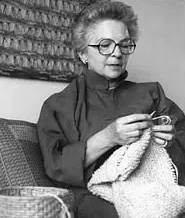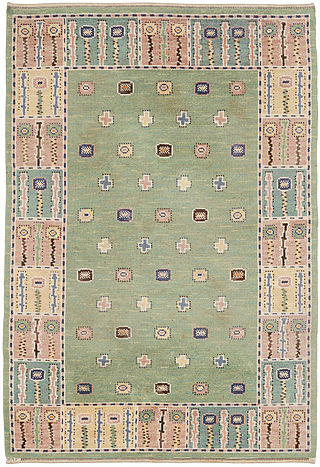
Tapestry is a form of textile art, traditionally woven by hand on a loom. Normally it is used to create images rather than patterns. Tapestry is relatively fragile, and difficult to make, so most historical pieces are intended to hang vertically on a wall, or sometimes horizontally over a piece of furniture such as a table or bed. Some periods made smaller pieces, often long and narrow and used as borders for other textiles. Most weavers use a natural warp thread, such as wool, linen, or cotton. The weft threads are usually wool or cotton but may include silk, gold, silver, or other alternatives.

A rug is a piece of cloth, similar to a carpet, but it does not span the width of a room and is not attached to the floor. It is generally used as a floor covering, or as a decorative feature.

Fiber art refers to fine art whose material consists of natural or synthetic fiber and other components, such as fabric or yarn. It focuses on the materials and on the manual labor on the part of the artist as part of the works' significance, and prioritizes aesthetic value over utility.

Anni Albers was a German-Jewish visual artist and printmaker. A leading textile artist of the 20th century, she is credited with blurring the lines between traditional craft and art. Born in Berlin in 1899, Fleischmann initially studied under impressionist painter Martin Brandenburg from 1916 to 1919 and briefly attended the Kunstgewerbeschule in Hamburg in 1919. She later enrolled at the Bauhaus, an avant-garde art and architecture school founded by Walter Gropius in Weimar in 1922, where she began exploring weaving after facing restrictions in other disciplines due to gender biases at the institution.

Sheila Hicks is an American artist. She is known for her innovative and experimental weavings and sculptural textile art that incorporate distinctive colors, natural materials, and personal narratives.

Mary Walker Phillips, was an American textile artist, author and educator. She revolutionized the craft of hand knitting by exploring knitting as an independent art form. Her hand-knit tapestries and other creative pieces are exhibited in museums in the U.S. and Europe. She was honored as a fellow by the American Craft Council (ACC) in 1978.
The Digswell Arts Trust was founded by Henry Morris in 1957 at Welwyn Garden City, Hertfordshire, England. It was founded to promote the use of professional artists to create civic artwork for the benefit of society.
Ida Mary Lough was a New Zealand weaver, recognised as one of the country's best tapestry makers.

Trude Guermonprez, was a German-born American textile artist, designer and educator, known for her tapestry landscapes. Her Bauhaus-influenced disciplined abstraction for hand woven textiles greatly contributed to the American craft and fiber art movements of the 1950s, 60s and even into the 70s, particularly during her tenure at the California College of Arts and Crafts.
Scandinavia has a long and proud tradition of rug-making on par with many of the regions of the world that are perhaps more immediately associated with the craft—regions such as China and Persia. Rugs have been handmade by craftspeople in the Scandinavian countries of Denmark, Finland, Norway, and Sweden for centuries, and have often played important cultural roles in each of these countries. Contemporary Scandinavian rugs—most especially Swedish rugs—are among the most sought after rugs in the world today, largely due to the contributions of designers like Märta Måås-Fjetterström. The story of Scandinavian rugs is a vital chapter in the cultural study of Scandinavia, as it reveals a great deal about the aesthetic and social conventions of that region.

Carpets and rugs have been handmade in Sweden for centuries, taking on many different forms and functions over the course of time. Rugs woven in the traditional Oriental manner, especially in the Ottoman Empire and points east, were originally brought to Sweden over trade routes as early as the early Middle Ages. In the centuries that followed, Swedish rug-makers often infused their works with themes and motifs traditionally found in Oriental rugs. Eventually, Swedish rug-makers would begin to use Oriental rug-making techniques, but themes and motifs more consistent with the artistic and cultural heritage of Sweden. By the early modern periods, rugs had long been an important avenue of art – especially folk art – in Swedish culture. By the beginning of the twentieth century, the craft was seen as being an important artistic and cultural practice throughout Sweden, and designers began to make rugs that had a broad international appeal. Swedish rugs from the mid-twentieth century remain among the most desirable and sought after in the rug world.

Helena Hernmarck is a Swedish tapestry artist who lives and works in the United States. She is best known for her monumental tapestries designed for architectural settings.

Uqqurmiut Centre for Arts & Crafts is an arts centre that was established by the Uqqurmiut Inuit Artists Association in 1990, in Pangnirtung, in the Qikiqtaaluk Region of Nunavut, Canada. The Centre includes a Tapestry Studio, a Craft Gallery, and Print Shop. In spite of its remote location and small population, numerous Inuit from Pangnirtung have successfully marketed their prints, carvings, sculptures, and textile arts, such as woven wall hangings, to southern collectors. Starting in the 1970s, limited edition prints from the original Print Shop were published annually as the Pangnirtung Prints Collection through the then-Eskimo Co-operative. In 1970 a weaving studio was established and over time the tapestries attracted an international market.

Minna Carolina Mathilde Louise "Loja" Gesellius(March 15, 1879 – April 21, 1968) was a Finnish-American textile artist and sculptor. She founded the weaving department at the Cranbrook Academy of Art in Michigan. She also led her own studio, the Studio Loja Saarinen, which designed many of the textiles used in buildings designed by her husband, the architect Eliel Saarinen.

The Khalili Collection of Swedish Textiles is a private collection of textile art assembled by the British-Iranian scholar, collector and philanthropist Nasser D. Khalili. The collection was built up over a period of 25 years and contains 100 works. It is one of eight collections assembled, conserved, published and exhibited by Khalili, each of which is considered among the most important in its field. In 2008 it was described as "the only extensive collection of Swedish flatweaves outside the country". The collection consists mostly of textile panels, cushion and bed covers from the Scania region of southern Sweden, dating in the main from a hundred-year period between the mid-18th and mid-19th centuries. The majority of the pieces in the collection were made for wedding ceremonies in the region. While they played a part in the ceremonies, they were also a reflection of the artistry and skill of the weaver. Their designs often consist of symbolic illustrations of fertility and long life. Khalili writes that he created the collection because of the tendency of art historians and the public to undervalue art whose creators are anonymous.
Archie Brennan (1931–2019) was a noted Scottish tapestry weaver. He served his apprenticeship at the Edinburgh Tapestry Co and studied at Edinburgh College of Art. He went on to work at the College establishing their department of Tapestry and Fibre Arts. He also served Dovecot as their artistic director.
Marcella Augusta Hempel, was a textile artist, second generation Bauhaus master weaver and lecturer in textiles. She was one of many émigré artists who came to Australia after the second world war, bringing training and expertise from Europe. She became a respected leader in the Australian Crafts Movement. Hempel designed and wove products such as rugs and scarves which were commissioned or exhibited by Australian companies, private collectors and craft and art galleries. Her work received a gold medal award from the Australian Wool Board. She lectured in Dresden then at the University of Applied Arts in Berlin, taught textile design at East Sydney Technical College, was the inaugural lecturer in textiles at the Riverina-Murray Institute of Higher Education and was conferred with a Honoris Causa award of Bachelor of Arts after retirement. Her woven travel rugs are held in national art collections.

Mary Zicafoose is an American textile artist, weaver, and teacher who specializes in ikat, an ancient technique in which threads are wrapped, tied and resist-dyed before weaving. Zicafoose is the author of Ikat: The Essential Handbook to Weaving Resist-Dyed Cloth (2020). Her works are part of private and public collections, including at least 16 embassies around the world as part of the U.S. Art in Embassies Program.
Jutta Feddersen was a German-born Australian fibre artist, sculptor, lecturer.

Charlotte Lindgren was a Canadian sculptor-weaver, installation artist, photographer and curator. Lindgren gained worldwide fame for innovative weaving due to the response to her distinctive installation Aedicule in the 1967 International Biennial of Tapestry in Lausanne, Switzerland. Her architectural textile works — usually large — are single woven planes that transform into three-dimensional forms. They explore the interplay between positive and negative spaces, allowing for dramatic shadows and movement.














